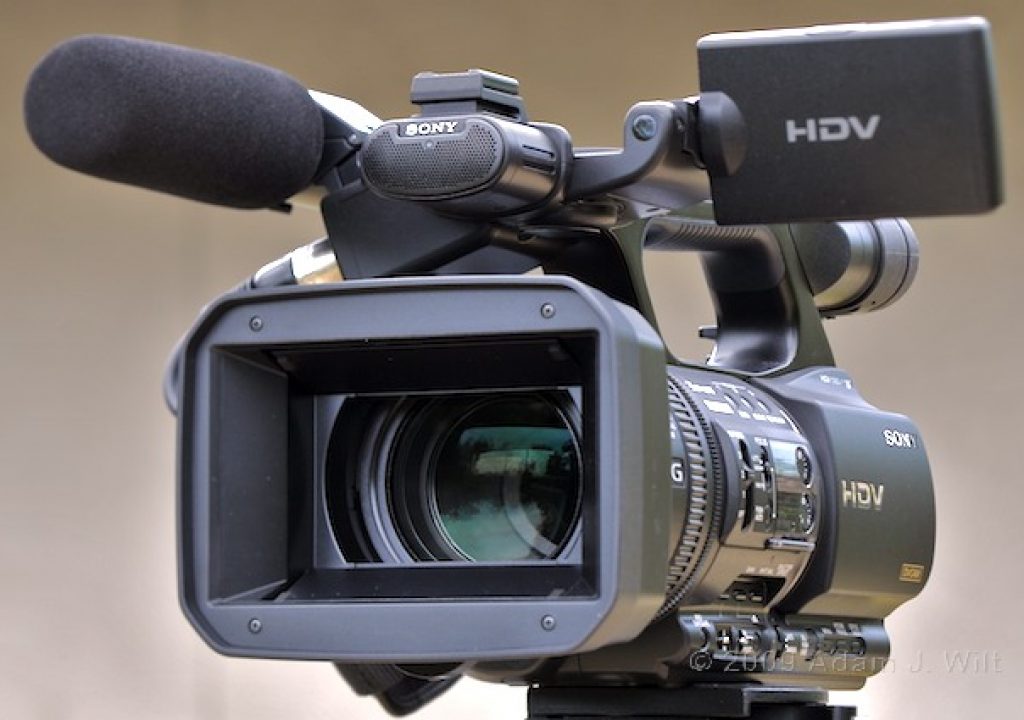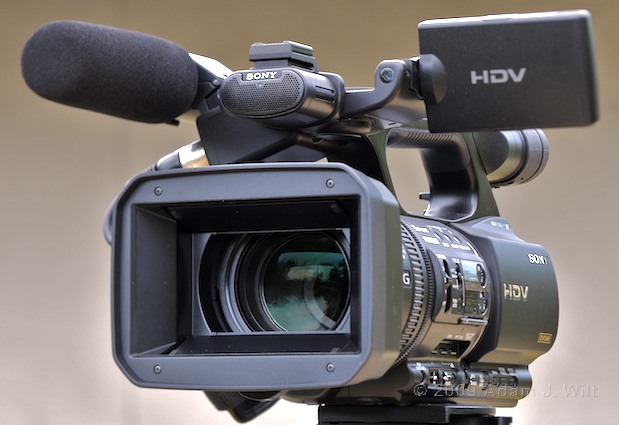
“When Sony bought Konica/Minolta”, says Sony’s Juan Martinez, “we suddenly became a major lens manufacturer.” One of the results of this acquisition is the HVR-Z5U, an HDV/DVCAM camcorder with a 20x fixed “G lens”. Consider it the wide-zooming half-brother of the HVR-Z7U, which shares much of what comes behind the lens.
The HVR-Z5U (US$4950 list price, $4200 street price) is a handheld camcorder recording 1080i HDV and standard-definition DV and DVCAM on miniDV tapes (and/or on CF cards with an optional MRC1 recorder). It weighs 5.4 pounds and is generally the same size as other HD handycams; by comparison, the HVR-Z1 is very slightly longer but a couple of ounces lighter, while the HVR-Z7U with its interchangeable lens is within half an inch of the Z5U’s dimensions, but weighs 6.2 pounds.
Note: all street prices shown are those listed by B&H Photo as of 2 May 2009.
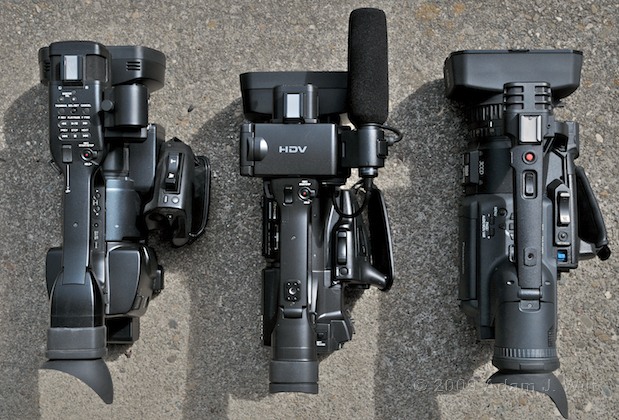
The HVR-Z5U between a PMW-EX1 and a Panasonic HVX200.
The Z5U is based on the same electronics as the Z7U (and its shoulder-mount sibling the S270U) and shares the same LCD and EVF. However, the Z5U sits behind a fixed, 20x “G” Sony lens, instead of the 12x interchangeable Zeiss lens on the Z7U. The physical layout of the Z5U differs from the Z7U, too, as do the I/O connectors, so despite their common cores the two camera have different operational personalities. If you’re looking into these two camcorders, the choice between them may depend as much on how naturally the controls fit your working style as much as on the differing qualities of their lenses or their prices (the HVR-Z7U is about $1200 more expensive than the Z5U).
That Big G-Series Lens
The Z5U is fronted with a hefty, 20x Sony “G” zoom. The G lens is a result of Sony’s absorption of Konica/Minolta and that company’s decades of experience in making still camera lenses. This lens uses two extra-low dispersion elements and three aspheric elements in pursuit of high performance, a wide zoom range, a relatively compact size, and an affordable price.
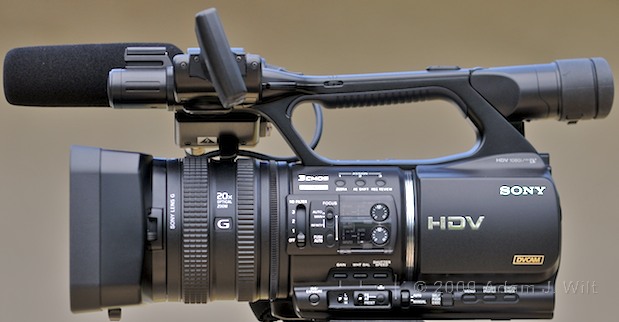
The operator’s side of the HVR-Z5U, with lens hood and short shotgun mic fitted.
It starts at 4.1mm and zooms to 82mm; in 35mm still-camera terms, Sony says that’s equivalent to 29.5mm – 590mm. Compare that to Sony’s figures for the HVR-Z7U (32mm – 384mm) or the EX1/EX3 (31.4mm – 439mm). In side-by-side tests I found the wide end to be virtually identical to the EX1’s in practical terms, and noticeably wider than the HVX200’s 4.2mm wide angle. Of course, the Z5U beats them all on the telephoto end.
The lens has three free-spinning servo control rings, for focus, zoom, and iris. These lack endstops or external scales, though the camera’s displays will show you focus in feet or meters, zoom setting as a bar graph or numbers from Z00 to Z99, and apertures to the quarter stop. Action on all rings is silky-smooth, instantly responsive, and consistent, with little lag and no overshoot; I never felt disconnected from the lens using these servos.
The focus and zoom controls use grippy, ridged rubber rings; they have similar textures and I often mistook one control for the other when finding them by feel. The iris ring is a thinner plastic “gear”, readily distinguishable by touch alone.
The focus ring can be set to allow manual override when autofocus is in use; this “AF Assist” mode is quite helpful when the autofocus decides to track the wrong subject.
The iris ring’s direction can be reversed (clockwise brighter or clockwise darker as you prefer), and it can be switched between iris-only control and overall exposure control, varying gain and/or shutter speed as needed when the limits of the iris have been reached: gain is changed when the iris is wide open, and shutter speed is varied when it closes down to f6.8 (though iris comes into play again once the shutter speed reaches 1/250 sec). When in exposure-control mode, you can still lock or set gain and shutter speed manually using their own controls; those parameters affected by the iris ring show a “E” beside their data readouts, so you stay in complete control at all times. It works quite well and makes manual control in widely-varying lighting a lot faster and more convenient. My only complaint is that I wish I could change the closed-iris limit where the shutter speed kicks in, as I can in auto-iris mode, to reduce resolution losses due to diffraction effects.
The lens takes a 72mm filter and comes with Sony’s excellent shutter-equipped lens hood: a lever flips open the top and bottom shutter panels serving as a built-in lens cap. The hood bayonets in place, locking with a pushbutton instead of a thumbscrew, so it’s latched securely in place yet can be removed with a minimum of fuss when necessary.
Sony’s Steadyshot optical stabilization is present, of course, and it allows for three different strength levels, plus a setting for the optional VCL-HG0872K wide-angle adaptor. The settings range from Soft, which only smooths things out a little, to Hard, which really tries to lock down the image, and reminds me of the more aggressive stabilization Canon uses on its high-end HDV camcorders. You can trade off fluidity against firmness as you see fit, or turn off Steadyshot completely for tripod work (or for that totally aggro shakycam look).
Camera Controls and Handling
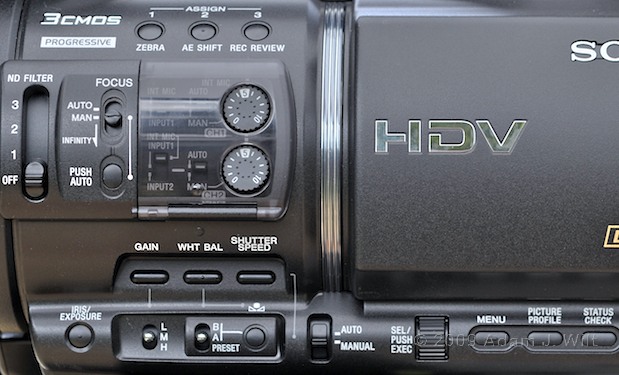
Most shooting controls are on the left side of the HVR-Z5U’s body.
Just behind the lens, a four-position slide switch controls three levels of ND filter: 1/4, 1/16, and 1/64, or 2, 4, and 6 stops of compensation. Conventional focus-selection controls follow: a manual/auto selector with a momentary infinity-focus position (which, like the same control on most other handycams, is too easy to accidentally activate when toggling from auto into manual), plus a “push auto” momentary autofocus button.
Across the lower edge of the body, a recessed niche holds auto/manual pushbuttons for gain, white balance, and shutter speed. Below that niche are the iris auto/manual pushbutton, three-position flip switches for manual gain and white balance selection, a white balancing pushbutton, a global auto/manual flip switch (so you can bounce between full auto and manual configurations with a single control), a menu and shutter speed thumbwheel, and pushbuttons for menus, picture profiles, and status checking. Button and switch stiffness is good overall, and I found that most controls were well placed and easily usable with a couple of exceptions: the “push auto” focus button isn’t well distinguished from its surroundings and can be difficult to locate by touch, and the thumbwheel is limited by a cramped location (the tape door juts out above it) and poor feel; it’s too easy to push the wheel in (thus selecting a parameter) when you really want to turn it (to change a parameter). I wound up using the optional RM-1000BP LANC controller for most of my menu and profile fiddling instead of struggling with the on-camera thumbwheel.

Audio level and channel selection controls behind a flip-down guard.
The Z5U offers comprehensive audio controls, with most of the immediate-use controls behind a guard panel on the left side. Flip switches select between the stereo internal microphone and dual XLR inputs and choose auto or manual gain; rotary controls set the manual recording level. Both channels are individually selectable and controllable; you can have one channel use an internal mike in auto gain while the other records from an XLR input in manual gain. Additional controls in the menu system let you vary mike-level input attenuators, engage a peak-end limiter in manual gain, turn on noise-reduction and wind noise filters, and choose whether AGC works in channel-linked mode (for stereo work) or separate mode (when the two channels are used for different purposes, like two lavs or a lav and a boom).
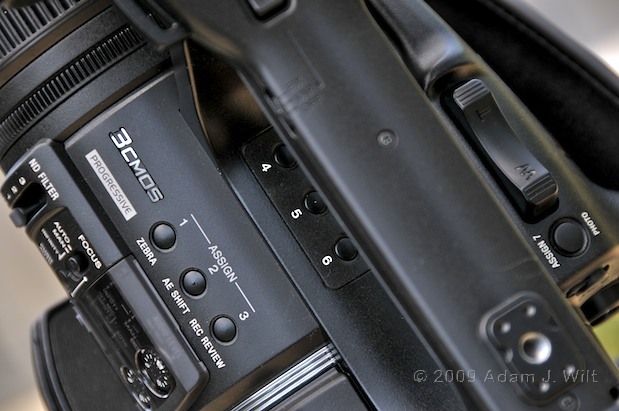
The HFR-Z5U’s assignable buttons.
The camera has seven assignable buttons, letting you customize the camera for your needs. Three run across the upper edge of the left side, three sit atop the body under the carrying handle, and one sits atop the handgrip just behind the zoom rocker. I instantly assigned geeky shooting things, like zebra, expanded focus, peaking, and color bars to the buttons, but they also allow one-button access to smooth slow recording (low-res, quarter-speed slo-mo), shot transitions (programmed focus/iris/zoom/white balance changes), a 1.5x digital zoom extender, enabling/disabling macro focus, and the usual selection of backlight, spotlight, index mark, hyper-gain, still photo, and other functions.

Tape loading: it’s like half the camera is spilling its guts…
The rear half of the left side flips open to reveal the top-loading tape transport. The HVR-Z5U records 1080i HDV as well as standard-definition DV SP and DVCAM. It will neither play nor record DV LP mode tapes.
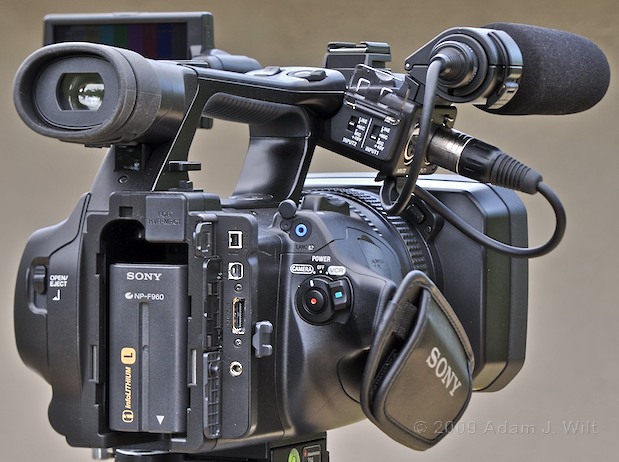
The HVR-Z5U’s rear panel, back of handgrip, and XLR controls.
The supplied NP-F770 infoLithium battery snaps into the back of the camera and is good for nearly three hours of use; I also used a larger F960 battery, which still fit entirely inside the battery well. An optional, $850 HVR-MRC1 compact flash recorder can be attached behind the battery, just as on the HVR-Z7U, and it functions the same way as on the Z7U.
Connectors on the Z5U have been pared down compared to those on other recent Sony HD camcorders. The six-pin i.Link (FireWire) socket we saw on the Z7U did not herald the future, alas: the Z5U’s i.Link socket is the smaller and more fragile four-pin job.
All analog I/O has been consolidated into the fat, round multipin connector used for composite, Y/C, and audio on other recent cameras; there’s no separate mini-D-shell component socket on the Z5U. Two cables are provided for this connector; one is the familiar composite video + stereo audio triple-RCA breakout cable, while the other is a five-RCA cable with analog component and stereo audio (obviously, both composite and component cannot be connected at the same time). While Y/C is available on the socket, Sony sadly neglects to provide a Y/C cable in the box; the VMC15FS breakout cable with the added connector is a $17 option.
A full-size HDMI socket provides digital audio and video, handy not just for monitoring but for connecting to a high-quality field recorder like the nanoFLASH or the Ki Pro, or capture cards from AJA or Blackmagic Design. Connecting HDMI disables the analog video outputs.
A headphone jack (with plenty of oomph to drive ‘phones to a high level) finishes off the rear connectors.
All these sockets are concealed behind hard plastic doors that flip open, with the exception of the HVR-MRC1 I/O connector, which lurks behind a pop-off (and easily lost) plastic cover. Even if the cover goes missing, the internal connector has a spring-loaded sliding dust cover, so it’s fairly resistant to the hazards of a cruel world.
On the back of the handgrip, just above the camera/VTR power switch and start/stop trigger, there’s a 2.5mm LANC remote jack with its own tethered rubber cover. The LANC command set for the Z5U, Z7U, and S270U is vastly expanded over that of previous cameras, and the $1200 RM-1000BP Remote Commander gives you full remote control over the camera.
The backside of the XLR pod has switches to set each of the two sockets to mike or line level and to enable +48v phantom power. Like the side-mounted audio controls, these are protected behind a flip-open transparent cover.
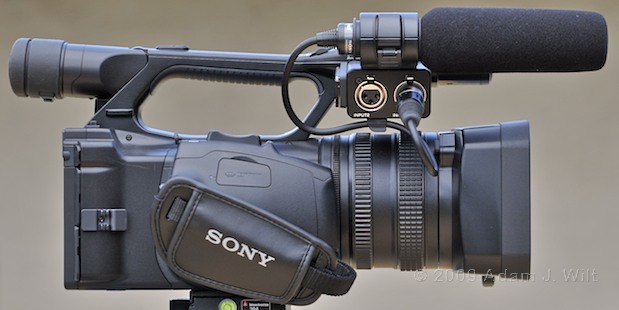
The right side of the HVR-Z5U.
The right side of the camera has the usual molded handgrip and handstrap, surmounted by a proportional zoom rocker. The rocker allows steady zooms of at least 60 seconds duration, with a smooth ramp up to a top speed of 2.5 seconds in the default setup or 1.5 seconds in “speed zoom”, which allows faster travel at the expense of a bit more motor noise.
The camera balances fairly well in the hand, though it’s ever so slightly front-heavy.
There’s a Memory Stick Pro Duo slot in the handgrip behind its own door. Memory Sticks are used both for still photos (which this camera can grab even while recording video) and for storing and transferring camera setups.
At the front, there are two XLR inputs located in the now-familar above-the-lens position Sony has been using for some time. Some folks look at that XLR location with disdain, but it’s just about the only place to fit two full-sized XLRs on a small camera without having them interfere with other controls, doors, or I/O ports.
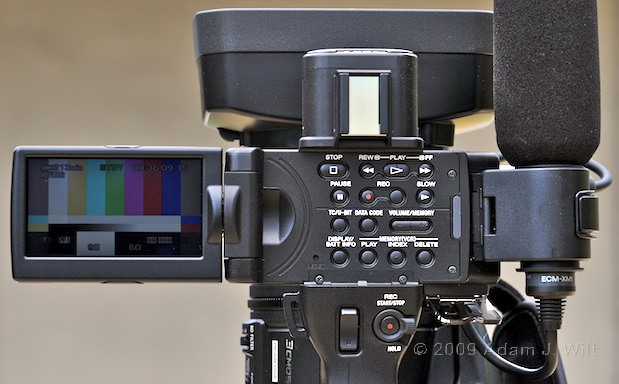
Top view: LCD, playback controls, multiple mics, and top-mounted zoom lever.
That XLR pod underlies the top-mounted control panel at the front of the carry handle. The 3.2″ flip-out LCD parks on top of the is control panel, and pivots up and out for use. The panel has the usual HDV transport controls (play, pause, rewind and fast-forward; slo-mo playback but no single-step control; record), a volume rocker for the headphones or (during playback) a small speaker mounted under the panel, and the like. The Display / Batt. Info button is used to declutter the data display; to show battery level when the camera is turned off (very handy); and, when held down, it toggles the LCD’s backlight.
In front of the control panel is a built-in stereo mike pod, and the Z5U is also supplied a separate short shotgun mike, the same ECM-XM1 used on the Z7U. While the stereo mikes project forward of the lens front, making it challenging to mount some lens accessories, I like having mikes always available without having to attach a separate unit.
There’s an accessory shoe atop the mike pod, and a 1/4×20 threaded socket atop the rear end of the handle, just in front of the EVF. As with the Z7U, a separate accessory shoe is provided that can be mounted over the threaded socket.
The Z5U has the usual top-mounted start/stop trigger with locking collar, and a tiny zoom rocker—but this zoom rocker isn’t the fixed-speed rocker we’re accustomed to seeing in this position. As on the Z7U, it’s a fully-variable control, albeit a slightly finicky one, given its small size (traditionalists can set the rocker to work at a fixed speed if they so desire). All top-mounted zooms should work this way!
Next: Performance and Features…
Performance and Features
Optics
The 20x G lens shows a fair amount of geometric distortion, but it’s a winner in sharpness, chromatic aberration, flare, and flatness of field.
The lens makes a crisp, sharp image throughout its zoom range. Its sweet spot is around f2.8; wider apertures show a very slight loss of high-frequency detail on the test charts, and below f4.4 resolution starts to fall off due to diffraction effects (as happens on all 1/3″ HD cameras), but practically speaking, keeping the aperture at f4.8 or wider will give you pin-sharp pictures throughout the zoom’s range.
Fully wide the lens shows a bit of mustache distortion: barrel distortion on the center of the image, with some slight pincushioning towards the edges that partially corrects the barrelling. As the lens zooms in, the barrel distortion recedes such that it’s counteracted by the pincushion, so that straight lines at the edge of the picture are pretty much straight overall (if a bit wavy) around Z10 (on the zoom’s displayed scale of Z00-Z99; actual focal lengths aren’t shown). Zoom in more, and pincushion distortion predominates, being worst around Z30-Z50 and then diminishing to Z80, after which distortion isn’t noticeable.
But, folks, it’s a 20x lens—this isn’t bad given the zoom range. I see comparable distortions in cine zooms costing 10 times what this camera costs. The Z5U wouldn’t be my first choice for architectural videos, but in most other situations it should be fine.
Interestingly, the optional VCL-HG0872K 0.8x wide-angle adaptor‘s slight barrel distortion works against the pincushioning to almost perfectly correct the lens throughout most of its range—though the wide end gets a bit fisheye-like.
The lens opens up to F1.6 aperture at full wide angle, and ramps smoothly down to a max aperture of 3.4 at full telephoto. Setting F3.4 on the iris preserves a flat exposure from Z00-Z89.
I wasn’t able to see a constant exposure through the entire zoom range at any indicated iris setting; zooming into the final 10% of the range (Z89-Z99) always caused a loss of about half a stop regardless of f-stop, visible on a waveform monitor if not apparent in the picture. Of course, if the camera is auto-exposing, it’ll compensate automatically as you zoom; this is only an issue when shooting in fully manual exposure mode
There is no perceptible vignetting (an smooth and even falloff of illumination towards the edges of the image) or portholing (an obvious circle of brightness with a dark surrounding) anywhere in the zoom range, even with the aperture wide open. Furthermore, I wasn’t able to see any corner darkening from the optical stabilization no matter how I shook the camera. This is a great lens for greenscreen work.
Chromatic aberration is well controlled. Some lateral green/magenta fringing is just barely noticeable full wide, and is slightly more present from Z90-Z99, but in the broad middle of the zoom’s range it’s imperceptible. Prism-induced vertical green/magenta fringing on out-of-focus objects if there is you’re looking for it, but it’s not objectionable in real-life shooting.
Lens flare is minimal; there’s a single, greenish ghost opposite any bright light shining directly into the lens, but that’s pretty much it. There’s a slight bit of veiling haze or glare, mostly when the lens is wide open; it’s also greenish in character, but it’s no worse overall than on other lenses of this type.
Like many modern zooms, the optical center shifts as you zoom in: foreground object creep towards the center of the image just as if you were dollying the camera back as you zoomed in (sort of a “Vertigo” effect). It’s no worse than on an EX1 or an HVX200; it’s just something that caught my eye during testing.
Resolution and Detail
The HVR-Z5U, like the Z7U and S270U before it, uses Sony’s ClearVid CMOS sensors, employing a diagonal array of 1440×810 photosites. When run through Sony’s Enhanced Image Processor ™, these sensors yield both actual and interpolated image samples, the latter being synthesized from four surrounding photosite values. Combined with the “Exmor” technique of using a dedicated A/D converter on each readout column, the result is a picture that’s a sharper and quieter than would otherwise be expected from the basic sensor specs; see Sony’s writeup for details.
The Z5U’s images are comparable to those of the Z7U and S270U: they’re nearly as sharp as images from full-resolution 1920×1080 sensors. The only real giveaway is that there’s some stair-stepping or jaggies on high-contrast edges, such as backlit window frames, specular highlights, and lighting fixtures.
On a DSC Labs Multiburst chart, the Z5U resolves 800+ TVl/ph both horizontally and vertically. As one might expect from the sensor’s design, diagonals show the most obvious aliasing, as you can see from these pixel-for-pixel extracts:
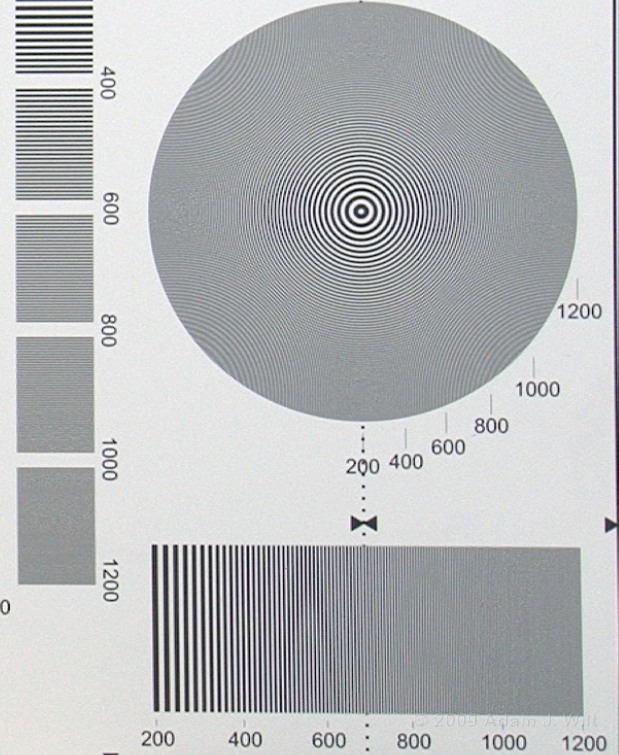
HVR-Z5U in 60i mode, f2.8, captured to 1920×1080 ProRes422 HQ via HDMI.
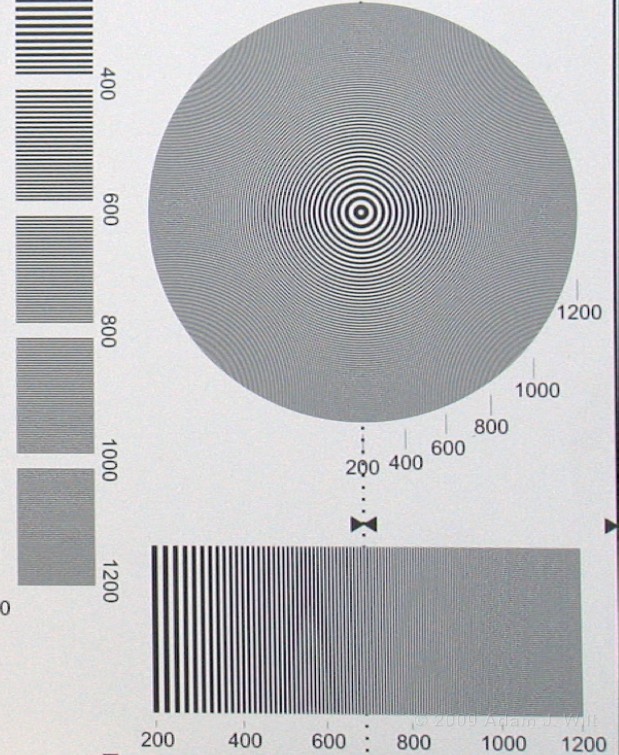
HVR-Z5U in 30p mode, f2.8, captured to 1920×1080 ProRes422 HQ via HDMI.
Compare these charts with the Z7U’s off-tape multiburst image. Since the Z5U’s off-tape image looked pretty much the same as the Z7U’s, I thought I’d show full-raster E-E images here so you can see more directly what the camera itself is doing.
(You can also see the pincushioning distortion in the Z5U’s lens; these images are of the lower right corner of the chart with the lens zoomed to Z48. My HVX200, shooting the same chart from the same location with roughly the same sensor size, tells me it’s using a 15mm focal length for that angle of view.)
Practically speaking, the images offer plenty of detail; aside from the occasional slightly steppy edge in extreme-contast situations, there’s nothing in the pictures that indicates they’re made with anything less than full-resolution sensors. I found that I was happy running the camera with its detail setting turned down to -5 or -6 (on a range of -7 to +7) because its images were pleasingly sharp without a lot of added enhancement.
However, that level of detail is compromised at high gain settings; as gain is increased above 9dB, resolution drops: at +21dB, it’s down to 600 TVl/ph. It isn’t just a build-up of image noise; the outer portions of the zone plate simply merge into undifferentiated gray areas as pixel-averaging appears to come into play to keep noise levels down.
The CMOS chips use a 1/60 second rolling shutter, so whip pans and very fast motions may show some tilt or distortion. Practically speaking, it takes a very fast move to show any noticeable tilt; it’s not an issue in most shooting.
HD downconversion and DVCAM recordings resolve all the detail that SD allows, but with some aliasing artifacts. Vertically the camcorder is good for 400 lines; in 4×3 it resolves about 540 TVl/ph and in 16×9 around 400 TVl/ph; above those points mild aliasing sets in and persists out towards 800 TVl. An ideal SD camcorder sees comparable amounts of detail but without the aliasing (note: few SD camcorders achieve this ideal state). The high-frequency aliasing shows up as moir© on fine patterns, like test charts (grin), chain-link fences receding into the distance, window screens, and the like. It’s a minor quibble, not a showstopper. The Z5U is far better than an EX1 or EX3 when it comes to downconversion.
Sensitivity, Noise, and Dynamic Range
I measured the Z5U at between ISO 400 and ISO 500, regardless of mode (interlaced or progressive); perhaps a quarter of a stop faster than the Z7U and S270U using the same sensors. This may be due to a difference in calibration, or the lens may be slightly more transmissive. If we say it’s ISO 400, the Z5U equals the EX1 in 1080p mode, and is a third of a stop faster than the HVX200, a stop faster than the Z1, and two stops faster than the V1.
Some of this speed may be due to the chips, and some due to more amplification in processing. The cameras’ images are as noisy at 0dB as the EX1’s and the Z1’s at around +3dB to +6dB. If you want cleaner images, the Z5U offers both -3dB and -6dB gain settings.
Speed ratings on digital sensors are somewhat arbitrary; normally the rating is set such that 0dB corresponds to the slowest exposure that allows for full highlight detail without clipping (thus, the best dynamic range combined with the lowest noise). Applying negative gain with such a rating normally results in some clipping of extreme highlights, due to sensor saturation.
However, Sony says (and I confirmed by experiment) that the negative gain settings on the Z5U do not result in any loss of detail in the highlights. It may be that Sony has simply rated these sensors a stop (6 dB) faster than they normally would to gain speed at the expense of noise, but you can choose to shoot at -6dB (ISO 200) for quieter images without sacrificing highlights.
Going the other way, you can boost gain to +21dB, though I found that going much beyond +12dB was inadvisable due to both noise and resolution loss (I found that boosting gain after the fact in Final Cut Pro gave me comparable noise but with more resolution; a +9dB scene boosted to match a +18dB scene matched for overall noisiness, but held more detail). There’s also a hyper gain mode, assignable to a button, which is useful in emergency situations when getting a picture—any picture— is more important than quality. Hyper gain boosts the image by over six stops, so it’s on the order of a +36dB to +42dB gain setting. You will, however, see nearly as much noise as signal in hyper gain pictures.
Recording Modes and Quality
The Z5U is just like the Z7U in this respect. It records 25 Mbit/second DV, DVCAM, and 1080-line HDV on miniDV tapes, and/or on an optional CF card recorder.
In HDV interlaced modes, the camera shoots 60i, 24p, and 30p as previous Sonys did: 2:2 pulldown for 30p, 2:3 pulldown for 24p. Two 24p modes are available: plain old 24, and 24A, in which “the phase of the 60i conversion is reset each time recording starts”, which lets some NLEs handle 24p extraction more easily: for example, if you bring such clips into FCP from CF cards or the HVR-DR60 disk recorder using Sony’s plugin for the the Log & Transfer window, FCP will remove the pulldown and record the 24p clips as ProRes422.
There are also true progressive HDV recording modes, recording 30p as 30 frames, and 24p as 24 frames, with no pulldown into interlaced formats. While these progressive formats are not backwards-compatible with older gear, they offer a more efficient use of the fixed bit rate, and in 24p especially the resulting data stream doesn’t need to be “reverse telecined” to extract the original 24 frames. For example, using Final Cut Pro 6.0.5 and feeding it a mixture of interlaced and progressive clips from the same tape, FCP captured all the interlaced material as 1080i60 regardless of camera frame rate, while the progressive 30p and 24p material showed up in the bin as 1080p30 and 1080p24 respectively.
In terms of image quality, the true progressive 30p and 24p are a bit more robust than the interlaced modes in “shakycam conniption” tests. While I could cause compression conniptions—severe, mosaic-like blocking defects over one or more frames—in all modes with a couple seconds of frenetic shakycam, the 24p progressive recording seemed to break up perhaps 30% less frequently than the 60i recordings, while the 30p footage was halfway between the 24p and the 60i footage.
In real-world footage, as with other HDV cameras, single frames show compression artifacts if you look for them, but in normal playback the images look fine, with perhaps a bit more visual noise as scene detail and motion increase. It takes pretty radical frame-to-frame changes to cause enough breakup to be seen in normal playback.
The Z5U can shoot interval (time-lapse) footage, and in DV modes it offer single-frame recording as well.
It has the same “Smooth Slow Recording” feature seen on other Sony HDV CMOS cams: it will shoot short bursts (3, 6, or 12 seconds) of low-resolution, high-speed footage (4x real time, or 120fps) to a memory buffer, then record it to tape. It’s a useful trick for quick-and-dirty motion analysis or stylistic slo-mo, but the images are of poor enough quality that they won’t intercut with normal clips:
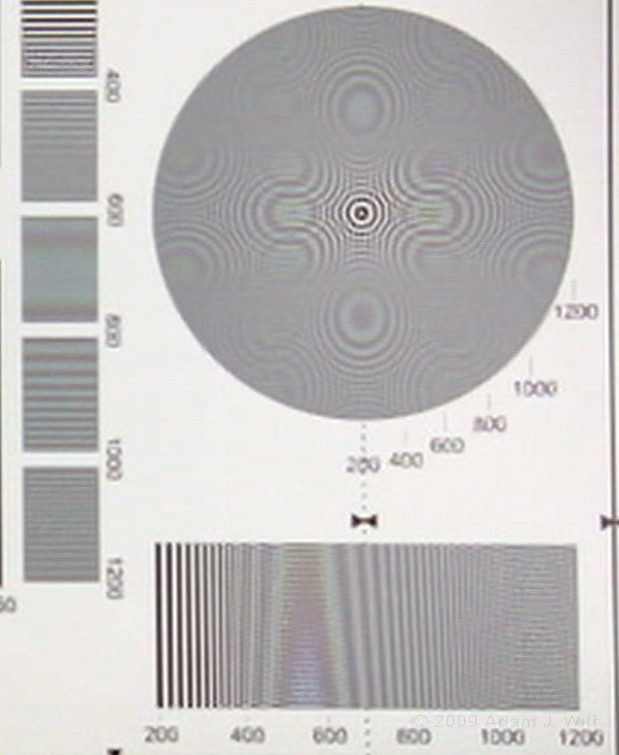
The same multiburst chart shot with 3-second Smooth Slow Recording. HDV frame grab stretched to 1920×1080 in Photoshop.
The 3 & 6 second modes resolve about 300 TVl/ph, while the 12 second mode drops to 250 TVl/ph. In all modes, capture is said to occur at 960x360p, with the 3 & 6 second modes converted to 672x360p images and the 12 second mode pix to 512x320p frames.
Even if it’s not perfect, Smooth Slow Recording comes free with the camera. It’s a lot cheaper than renting a Phantom for a day.
Displays
The EVF and LCD crop a couple of percent of the image laterally but show 100% of the picture vertically. The LCD panel is 1920×480, or 640 RGB triads x 480 lines, while the EVF is an RGB-sequential 852×480 LCOS panel (there’s some color shimmering during rapid eye movement, but the tradeoff is a superbly smooth and naturalistic image). Neither display shows any visible pixel gridding. Both are good for roughly 350 TVl/ph of resolution, which is detailed enough given the size of the screens. Yes, I’d like bigger ones capable of showing even more detail: the LCD is 3.2″ diagonally, yet its image seems far smaller than the picture on an EX1’s 3.5″ LCD; the magnification of the EVF is similarly small compared to that of the EX1. Nonetheless, these are comparable to the displays on the Z7U, which I happily used for a doc with very few shots lost to blown focus.
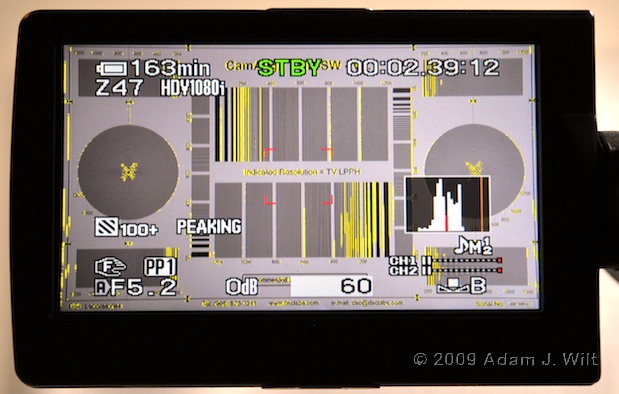
The Z5U’s LCD with yellow peaking on.
Like other recent Sonys, the displays can be filled with well-designed data readouts, or decluttered at the push of a button. All exposure parameters can be shown even when they’re automatically set (in which case a small, inverse-video “A” appears beside them). Both a zebra (settable from 70% to 100+%) and histogram are available for keeping tabs on exposure.
The infoLithium battery keeps you apprised of its estimated remaining time in minutes. The zoom setting, if set to numerical readout, is always present; the focus reading only appears briefly while you’re focusing.
Three levels of digital peaking are available, and peaking can be shown in white, yellow, or red. Expanded focus blows up the middle of the image by a factor of two for more precise focusing; unfortunately it cannot be used while recording, which is when you need it most.
The EVF and LCD show clean, consistent color. The EVF, being sequentially illuminated with separate R, G, & B LEDs, doesn’t suffer from any angular color shift, and the LCD, while not perfect, is still very good at holding both color and tonal scale values as your viewing angle changes. I felt confident relying on them to show me what I was really getting.
Audio
The built-in stereo mikes record clear and vivid sound, as did the short shotgun. As is usually the case, the on-camera shockmount is barely adequate to isolate the mike from handling noises, though it’s slightly better at isolation than the built-in mikes are. I found that the built-ins tended to record more high-frequency handling and tape-transport noises, while the short shotgun caught more of the low grumble of the zoom motor and the rumble of moving the camera from hand to hand; the shotgun generally had a deeper bass response overall. Both mikes did a fine job of picking up zoom motor noise whether or not “speed zoom” was engaged. Really, if you want to avoid camera noise, get the mikes away from the camera—this isn’t specific to the Z5U at all.
The camera’s wind noise filters roll off lower frequencies effectively, but I couldn’t hear any difference in the sound whether I used MIC NR or not.
The stereo mikes captured a realistic stereo soundscape. The short shotgun is mono, but more directional, with a tight cardioid pattern than did a good job of favoring frontal sounds over those from the sides and rear.
The headphone output is quite clean, and packs enough punch to make your ears bleed if you’re incautious with volume and gain.
Picture Profiles
The cameras offer six sets of custom presets, called Picture Profiles. These let you change the way the camera renders its images:
- Vary the master black level, along with R, G, and B black levels individually.
- Choose a gamma setting from Standard (like 709 gamma but with slightly compressed highlights), Cinematone 1, Cinematone 2, ITU709, ITU709 with a toe slope of 5 instead of 4.5 for increased shadow separation, PD to better match DCR-PD-series camcorders (slightly crushed, contrastier shadows), and x.v. for x.v.Color (wide gamut) recording (like 709 with slight black stretch). Cinematones have depressed midtones, as seen on other Cinematone-capable Sonys.
- Black gamma: change the shadow gamma range between low (below 15% brightness) / medium (up to 25%) / high ( up to 50%), and vary black stretching or compression over a 15-step range.
- Knee: Choose auto or manual knee; set the auto knee’s sensitivity and maximum allowed white level; set the manual knee’s setpoint and slope.
- Color mode: Choose between standard, 709, and two Cinematone matrices, and mix between the selected matrix and standard over an 8-step range. I found the standard matrix looked very much like 709 on other cameras, while 709 seemed oversaturated.
- Color level (saturation) and phase (hue).
- Color depth: for each of the six primary and secondary colors, vary the brightness of that color while keeping its saturation constant: the waveform monitor changes as you tweak a color, while the vectorscope doesn’t!
- Color Correct: pick one or two colors in a scene, and vary their hue and saturation independently, or vary their R gain and B gain independently. Alternatively, isolate those colors and let the rest of the image go monochrome.
- WB Shift: vary the camera’s idea of white, either by warm/cool and green/magenta controls (thus giving you both “color temperature” and “tint” controls), or by R gain and B gain.
- Detail: vary the detail level over 15 steps; turn detail on or off; change H/V balance; positive-going/negative-going enhancement balance; black and white limits; crispening; and highlight detail setting. In sub-$15,000 cameras, only the EX1 and EX3 give you more control of the detail signal.
- Skintone detail: choose a color to undo or limit the effects of detail enhancement on.
- Name the profile; copy it to another profile setting, or reset it to defaults.
Other Functions and Features
- You can set an assignable button to PHOTO, and grab still images to Memory Stick even as you’re recording to tape or CF card.
- Up to 99 camera setups can be saved to a Memory Stick, and moved between cameras.
- You can set the smallest aperture used in auto-iris mode to any half-stop setting from f4 to f11, to avoid diffraction-related sharpness loss.
- Shot Transition lets you store two combinations of focus, zoom, and exposure settings and move between them in a programmed manner. It’s like a shotbox, or a camera-parameter motion-control system, great for “hitting marks” in a repeatable manner. The Z5U allows transition times as long as 90 seconds (the Z7U and S270U only go out to 60 sec. on the slow end; the Z1 and V1 only go out to 15 sec.) and offers the “soft trans” and “soft stop” settings (basically, ease in and ease out) missing on the Z7U and S270U.
- Extended Clear Scan shutter speeds let you precisely dial out the flicker of CRTs and other annoyingly flickery things.
- You can vary the responsiveness/speed of auto-exposure and auto-white-balance tracking, and set the speed at which gain and white balance switch changes are performed, allowing smoother gain and color changes.
- You can enable x.v.Color mode, which overrides many of the image adjustments, to record in an expanded-gamut mode. The visual effect on a normal display is that saturation appears to drop slightly; on a wide-gamut display, the saturation range of colors is expanded.
- HD pictures can be downconverted to SD on all outputs (including i.Link) in letterbox, squeeze, or edge-cut modes.
- DV/DVCAM can be recorded in 4:3 or 16:9 modes.
- Timecode is fully tweakable: Preset vs. Regen, DF vs. NDF, etc. (note that timecode is always 30fps timecode; in progressive 24p recording, the clip timecode is discontinuous, skipping one frame number in five. This doesn’t seem to cause any problems in FCP 6, but your mileage may vary).
Next: Conclusions, Pros/Cons/Cautions, Other Resources
Conclusions
With the HVR-Z5U, Sony brings the same level of resolution, quality, and flexibility to its fixed-lens lineup as the Z7U and S270U deliver with interchangeable lenses.
The Z5U lets you shoot to tape or to CF card, or both at the same time, so you can work with the familiar tape-based workflow or the solid-state file-based workflow as you see fit. Its HDMI output connects with third-party capture cards and portable recorders for full digital recording at better than HDV quality levels, too.
It handles standard-definition DV and DVCAM as well as 1080-line HDV, so you’re able to handle SD and HD gigs with equal ease. And while the stock Z5U is a 60 Hz-only camcorder, it (and the Z7U and S270U) can be upgraded to 50/60 Hz “WorldCam” functionality for an additional $300.
The Z5U’s3 CMOS imagers deliver a reasonable tradeoff between resolution, sensitivity, and noise, delivering beautiful images with only the occasional telltale artifact that they aren’t full-res sensors. Its controls over color, exposure, knee, gamma, and detail give you ample ability to change the look of the picture. Smooth Slow Record gives you 4x slo-mo capability, albeit in short bursts with sub-SD resolution.
The HVR-Z5U’s basic image quality is equal to that of the Z7U and S270U, but it’s $1200 cheaper than the Z7U, as well as being slightly lighter in the hand.
The Z5U’s 20x G lens goes a bit wider and longer than the Z7U’s stock lens, and it has less chromatic aberration. On the flip side, the Z7U’s 12x Zeiss has lower distortion. What’s important to you?
The Z5U handles like a grown-up handycam, with Sony’s superbly smooth servo lens controls and with controls placed in the same positions you’ll find ’em on other handycams. The Z7U strives more to be a miniature “big” camera in its design philosophy.
The Z5U has both built-in stereo mikes and a separate shotgun; the Z7U has only the shotgun.
If you need interchangeable lenses (and I don’t mean “do you think it would be nice?”, I mean “do you really have plans to swap lenses?”) then the Z7U is the one to get. If you’re happy with the range of the Z5U’s lens, why pay more for functionality you’re not going to exploit?
In short, it’s hard to pick winners in the battle of the high-end Sony HDV cams. Beyond that, it’s silly. The Z5U simply expands the choices in the 1/3″ ClearVid CMOS lineup.
Pros
- 20x G zoom.
- ISO 400 nominal sensitivity (ISO 200 at -6dB gain).
- 800+ TVl/ph resolution with acceptably smooth, natural detail.
- DV, DVCAM, and 1080-line HDV recording.
- Upgradeable to 50/60Hz “WorldCam” flexibility.
- Interlaced and true progressive modes.
- Killer EVF and very good LCD; good peaking control.
- Best-in-the-business viewfinder data displays.
- Sensible ergonomics and superb, silky-smooth lens servos.
- Sony Steadyshot with several “firmness” settings.
- Comprehensive Picture Profile tweaks, most with 15 steps of adjustment.
- Very good shotgun mike included along with good built-in stereo mike.
- HDMI output.
Cons
- Lens has a fair amount of distortion through much of its range.
- Resolution drops with increased gain.
- Smooth Slow Motion clips have low resolution and many compression artifacts.
- Lens servo rings aren’t end-stopped, labeled, or calibrated.
- Expanded focus function can’t be used while recording.
Cautions
- 25 Mbit/sec HDV can break up when heavily stressed.
- Progressive modes not playable on older gear; may not yet be accessible in all NLEs.
- CMOS rolling shutter.
- Z7U & S270U in-viewfinder tilt indicator isn’t present in the Z5U.
- HVR-MRC1 CF card recorder is optional; it’s not included with the Z5U.
Other Resources
Upgrade a Z5U, Z7U, or S270U with WorldCam (50 Hz) capability.
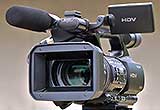

Filmtools
Filmmakers go-to destination for pre-production, production & post production equipment!
Shop Now